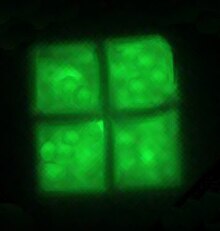A.E. Walsby

Haloquadratum walsbyi
Anthony Edward Walsby, FRS (died April 14, 2024[1]) was the Emeritus Professor of Microbiology at the School of Biological Sciences, University of Bristol.[citation needed]
He was a researcher in the fields of Algae, Cyanobacteria, lake ecology, gas vesicles and genetics, covering the European lakes and Baltic Sea.[2] He is noted for his discovery of Haloquadratum walsbyi in brine ponds on the Sinai Peninsula in 1980.[3] He was elected Fellow of the Royal Society, 11 March 1993.[4]
Specifically his research included:
- Gas vesicles of cyanobacteria: physiology; structure; molecular biology; ecology
- The natural selection of gas vesicles in relation to depth of lakes and oceans
- Population genetics of cyanobacteria using PCR on single filaments from lakes
- The cyanobacterium Planktothrix rubescens in stratified lakes
- Calculating the daily integrals of growth and photosynthesis in lakes
Selected publications[edit]
- Fay, P., & Walsby, A. E. 1966. Metabolic activities of isolated heterocysts of the blue-green alga Anabaena cylindrica. Nature, 209(5018), 94-95.
- Walsby, A. E., & Eichelberger, H. H. 1968. The fine structure of gas-vacuoles released from cells of the blue-green alga Anabaena flos-aquae. Archiv für Mikrobiologie, 60, 76-83.
- Walsby, A. E. 1969. The permeability of blue-green algal gas-vacuole membranes to gas. Proceedings of the Royal Society of London. Series B. Biological Sciences, 173(1031), 235-255.
- Walsby, A. E. 1972. Structure and function of gas vacuoles. Bacteriological reviews, 36(1), 1-32.
- Walsby, A. E. 1974. The isolation of gas vesicles from blue-green algae. In Methods in enzymology (Vol. 31, pp. 678-686). Academic Press.
- Blaurock, A. E., & Walsby, A. E. 1976. Crystalline structure of the gas vesicle wall from Anabaena flos-aquae. Journal of molecular biology, 105(2), 183-199.
- Hayes, P. K., & Walsby, A. E. 1986. The inverse correlation between width and strength of gas vesicles in cyanobacteria. British phycological journal, 21(2), 191-197.
- Walsby, A. E., & Hayes, P. K. 1988. The minor cyanobacterial gas vesicle protein, GVPc, is attached to the outer surface of the gas vesicle. Microbiology, 134(10), 2647-2657.
- Walsby, A. E., & Hayes, P. K. 1989. Gas vesicle proteins. Biochemical Journal, 264(2), 313.
- Walsby, A.E. 1991. The mechanical properties of the Microcystis gas vesicle. Journal of General Microbiology 137, 2401–2408.
- Walsby, A.E., Revsbech, N.P. & Griffel, D.H. 1992. The gas permeability coefficient of the cyanobacterial gas vesicle wall. Journal of General Microbiology 138, 837–845.
- Buchholz, B.E.E., Hayes, P.K. & Walsby, A.E. 1993. The distribution of the outer gas vesicle protein, GvpC, on the Anabaena gas vesicle, and its ratio to GvpA. Journal of General Microbiology, 139, 2353–2363.
- Walsby, A.E. 1994. Gas vesicles. Microbiological Reviews, 58, 94-144.
- Kinsman, R., Walsby, A.E. & Hayes, P.K. 1995. GvpCs with reduced numbers of repeating sequence elements bind to and strengthen cyanobacterial gas vesicles. Molecular Microbiology, 17, 147–154.
- McMaster, T.J., Miles, M.J. & Walsby, A.E. 1996. Direct observation of protein secondary structure in gas vesicles by atomic force microscopy. Biophysics Journal, 70, 2432–2436.
- Walsby, A.E., Hayes, P.K., Boje, R. & Stal, L.J. 1997. The selective advantage of buoyancy provided by gas vesicles for planktonic cyanobacteria in the Baltic Sea. New Phytologist, 136, 407–417.
- Walsby, A.E., Avery, A. & Schanz, F. 1998. The critical pressures of gas vesicles in Planktothrix rubescens in relation to the depth of winter mixing in Lake Zurich, Switzerland. Journal of Plankton Research 20: 1357–1375.
- Walsby, AE. (2005) Archaea with square cells. Trends in Microbiology, 13, 193 - 195.
- Dunton, PG & Walsby, AE. (2005) The diameter and critical collapse pressure of gas vesicles in Microcystis are correlated with GvpCs of different length. FEMS Letters, 247, 37 - 43.
- Walsby, AE. (2005) Stratification by cyanobacteria in lakes: a dynamic buoyancy model indicates size limitations met by Planktothrix rubescens filaments. New Phytologist, Blackwell, 168 (2), 365 - 376.
- Walsby, AE & Holland, DP. (2006) Sinking velocities of phytoplankton measured on a stable density gradient by laser scanning. Journal of the Royal Society Interface, The Royal Society, 3 (8), 429 - 439.
- Dunton, PG, Mawby, WJ, Shaw, VA & Walsby, AE. (2006) Analysis of tryptic digests indicates regions of GvpC that bind to gas vesicles of Anabaena flos-aquae. Microbiology, Society for General Microbiology, 152 (6), 1661 - 1669.
- Walsby, AE & Dunton, PG. (2006) Gas vesicles in actinomycetes? Trends in Microbiology, Elsevier, 14 (3), 99 - 100.
- Walsby, AE. (2006) Gordon Elliott Fogg CBE, 26 April 1919 - 30 January 2005. Biographical Memoirs of Fellows of the Royal Society, Royal Society, 52, 97 - 116.
- Walsby, AE, Schanz, F & Schmidt, M. (2006) The Burgundy-blood phenomenon: a model of buoyancy change explains autumnal waterblooms of Planktothrix rubescens in Lake Zurich. New Phytologist, Blackwell, 169 (1), 109 - 122.
- Walsby, AE & Juttner, F. (2006) The uptake of amino acids by the cyanobacterium Planktothrix rubescens is stimulated by light at low irradiances. FEMS Microbiology Ecology, Blackwell, 58 (1), 14 - 22.
References[edit]
- ^ "Professor Anthony Walsby FRS". Royal Society. 31.05.2024.
{{cite web}}: Check date values in:|date=(help)CS1 maint: url-status (link) - ^ "Details of Professor A. WALSBY" Ocean Expert, 2002-03-02
- ^ Walsby, A. E. (1980). "A square bacterium". Nature. 283 (5742): 69–71. doi:10.1038/283069a0. S2CID 4341717.
- ^ "Royal Society". The Independent. 13 March 1993. Archived from the original on 2012-11-10. Retrieved July 28, 2010.
